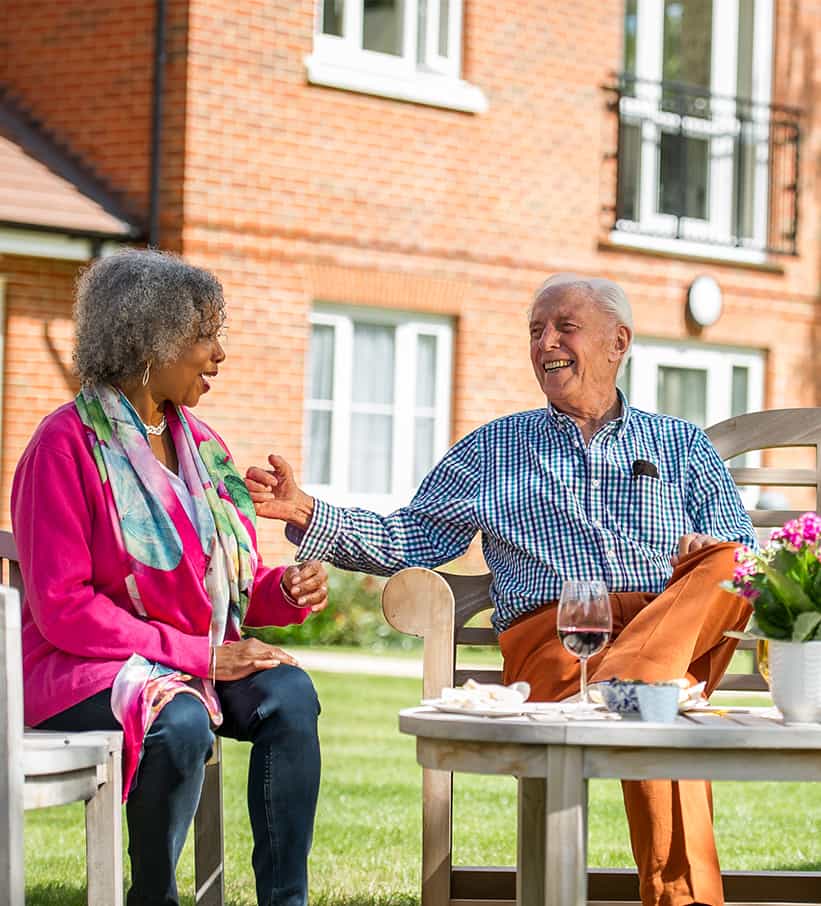
Homes for Later Living
Homes for Later Living seeks to promote greater choice, availability and quality of housing specifically built for older people. It comprises of Churchill Retirement Living, McCarthy Stone and Lifestory Group (made up of Pegasus and Renaissance) and operates alongside the Retirement Home Builders Group within the Home Builders Federation (HBF).
Our objective is to make the case for more places to live that are specially designed for older people, offering independence and privacy along with peace of mind and a ready-made social community. Typically designed for people who no longer want or need a family-sized house, accommodation of this type typically includes self-contained apartments or bungalows that are safe, secure and low-maintenance, plus significant shared spaces.
Varying levels of care and support are available and all schemes are underpinned by an on-site manager or team which look out for residents’ welfare and help with day-to-day matters.
Scroll down to find out about new research on the health and wellbeing benefits of homes for later living.

Homes for Later Living
Homes for Later Living seeks to promote greater choice, availability and quality of housing specifically built for older people. It comprises of Churchill Retirement Living, McCarthy Stone and Lifestory Group (made up of Pegasus and Renaissance) and operates alongside the Retirement Home Builders Group within the Home Builders Federation (HBF).
Our objective is to make the case for more places to live that are specially designed for older people, offering independence and privacy along with peace of mind and a ready-made social community. Typically designed for people who no longer want or need a family-sized house, accommodation of this type typically includes self-contained apartments or bungalows that are safe, secure and low-maintenance, plus significant shared spaces.
Varying levels of care and support are available and all schemes are underpinned by an on-site manager or team which look out for residents’ welfare and help with day-to-day matters.
Scroll down to find out about new research on the health and wellbeing benefits of homes for later living.
SILVER SAVIOURS FOR THE HIGH STREET
Published in February 2021, a new report commissioned by Homes for Later Living explores how building more specialist housing for older people would not only help an ageing population move into the home they desire and benefit the housing market, it would also help local economies grow more effectively in the wake of the pandemic.
The research was undertaken, evaluated and written by a former HM Treasury economist, Chris Walker, and finds:
1. Retirement properties create more local economic value and more local jobs than any other type of residential development.
2. For just one retirement development, a local authority could expect to see benefits of 85 construction jobs for the duration of the build, as well as six permanent jobs and £13m in Gross Value Added over the lifetime of the development, as opposed to not developing a site.
3. People living in each retirement development generate £550,000 of spending per year, £347,000 of which is spent on the local high street. Some £225,000 of this is new spending in the local authority, directly contributing to keeping local shops open.
4. From these figures, we estimate that a typical retirement housing development has the potential to support more than three local retail jobs.

SILVER SAVIOURS FOR THE HIGH STREET
Published in February 2021, a new report commissioned by Homes for Later Living explores how building more specialist housing for older people would not only help an ageing population move into the home they desire and benefit the housing market, it would also help local economies grow more effectively in the wake of the pandemic.
The research was undertaken, evaluated and written by a former HM Treasury economist, Chris Walker, and finds:
1. Retirement properties create more local economic value and more local jobs than any other type of residential development.
2. For just one retirement development, a local authority could expect to see benefits of 85 construction jobs for the duration of the build, as well as six permanent jobs and £13m in Gross Value Added over the lifetime of the development, as opposed to not developing a site.
3. People living in each retirement development generate £550,000 of spending per year, £347,000 of which is spent on the local high street. Some £225,000 of this is new spending in the local authority, directly contributing to keeping local shops open.
4. From these figures, we estimate that a typical retirement housing development has the potential to support more than three local retail jobs.
Chain Reaction
Our second paper, published in August 2020, explores how building more specialist housing for older people would not only help an ageing population move into the home they desire, it would also help first-time buyers join the housing ladder through the new chains that are created. The main findings of the report found:
1. c.3m older people in the UK aged 65+ want to downsize.
2. If, overtime, all of those aged 65+ who want to move were able to do so, it would free up nearly two million spare bedrooms, predominantly in three bedroom homes with gardens, ideally suited for young families with children.
3. The chain impact would be a major boost for first time buyers, with roughly two in every three retirement properties built releasing a home suitable for a first-time buyer in the housing chains created.
4. Overall, every Homes for Later Living property sold generates two moves further down the housing chain, and in certain circumstances this may be more. If 30,000 later living properties were built per year (10% of the Government’s overall housing target) this would mean at least 60,000 or more additional house moves are facilitated each year.

Chain Reaction
Our second paper, published in August 2020, explores how building more specialist housing for older people would not only help an ageing population move into the home they desire, it would also help first-time buyers join the housing ladder through the new chains that are created. The main findings of the report found:
1. c.3m older people in the UK aged 65+ want to downsize.
2. If, overtime, all of those aged 65+ who want to move were able to do so, it would free up nearly two million spare bedrooms, predominantly in three bedroom homes with gardens, ideally suited for young families with children.
3. The chain impact would be a major boost for first time buyers, with roughly two in every three retirement properties built releasing a home suitable for a first-time buyer in the housing chains created.
4. Overall, every Homes for Later Living property sold generates two moves further down the housing chain, and in certain circumstances this may be more. If 30,000 later living properties were built per year (10% of the Government’s overall housing target) this would mean at least 60,000 or more additional house moves are facilitated each year.
Healthier and Happier
Our first report, Healthier and Happier, was published in September 2019 and explored the wellbeing benefits that residents gain from living in specialist retirement housing and the significant fiscal savings they can deliver to the NHS and social care system. It found that:
1. People living in a property of this type typically experience reduced health risks, contributing to fiscal savings to the NHS and social care services of c.£3,500 per person per year.
2. Building 30,000 more retirement housing dwellings every year for the next 10 years could generate fiscal savings across the NHS and social services worth £2.1bn per year.
3. Using established national well-being criteria for happiness and life satisfaction, an average person aged 80 feels as good as someone aged 10 years younger after moving from mainstream housing to house specially designed for later living.

Healthier and Happier
Our first report, Healthier and Happier, was published in September 2019 and explored the wellbeing benefits that residents gain from living in specialist retirement housing and the significant fiscal savings they can deliver to the NHS and social care system. It found that:
1. People living in a property of this type typically experience reduced health risks, contributing to fiscal savings to the NHS and social care services of c.£3,500 per person per year.
2. Building 30,000 more retirement housing dwellings every year for the next 10 years could generate fiscal savings across the NHS and social services worth £2.1bn per year.
3. Using established national well-being criteria for happiness and life satisfaction, an average person aged 80 feels as good as someone aged 10 years younger after moving from mainstream housing to house specially designed for later living.
